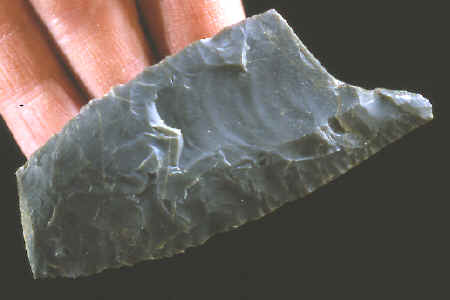|

CLICK ON
PICTURE FOR LARGE TRIPLE IMAGE
FLUTED POINT
VAIL SITE
OXFORD COUNTY, MAINE
By
Richard Michael Gramly, Ph.D.
This large fluted point showing signs of extensive reworking because
of damage by use (?) has been refitted from fragments found
separately at the Vail kill and habitation sites. The sites lie on
opposite sides of an ancient channel of the Magalloway River.
The
ear (Vail 4121) was unearthed at Locus E of the habitation site
during 1980 excavations; while, the matching tip was found in
December, 2001, on the surface of Vail kill site #1 by amateur
archaeologist John Halunen of Farmington, Maine.
The
edges of the spear point are very fresh and unweathered suggesting
that it was only recently exposed by the waters of man-made
Aziscohos Lake, The raw material appears to be Cambro-Orodovician
chert, possibly from a distant lithic source.
This
conjoined specimen is one of seven linking the Vail habitation and
kill sites. Seasonal interception of herd animals, likely caribou,
by a large band of hunters is suggested. |